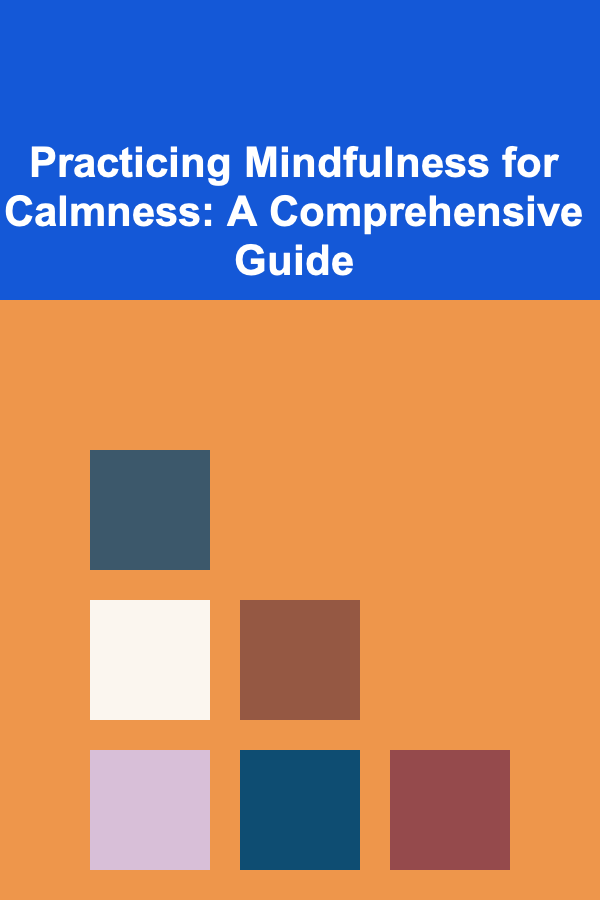
How to Deepen Your Meditation Practice
ebook include PDF & Audio bundle (Micro Guide)
$12.99$11.99
Limited Time Offer! Order within the next:

Meditation is a powerful tool for cultivating mindfulness, inner peace, and emotional resilience. As an ancient practice with roots in spiritual traditions across the world, meditation has gained widespread popularity in modern times due to its proven benefits for mental, emotional, and physical health. However, for many practitioners, meditation begins as a simple way to relax and clear the mind but can evolve into something much deeper and more transformative with time and practice.
Deepening your meditation practice requires a willingness to explore new techniques, commit to consistent practice, and embrace the journey with patience and openness. In this article, we will explore how to deepen your meditation practice by integrating advanced techniques, creating a supportive environment, addressing common obstacles, and fostering the mindset required for deeper awareness and spiritual growth.
Establish a Solid Foundation: Consistency is Key
Before diving into advanced meditation techniques, it's important to lay a strong foundation. Meditation is a skill, and like any skill, it requires regular practice to improve. If you've just started, it's essential to commit to a consistent practice, even if it's only for a short period each day. Meditation is not a one-time event or something that can be mastered overnight. It's an ongoing journey, and consistency is the first step toward deepening your experience.
Creating a Daily Meditation Routine
The most effective way to deepen your meditation practice is through daily meditation. Even short sessions, such as 10-15 minutes a day, can have profound benefits if practiced regularly. As you become more comfortable with the practice, you can gradually extend the time.
- Start small: If you're new to meditation, begin with short sessions of 5-10 minutes. As you become accustomed to the practice, gradually increase the length of your sessions.
- Set a consistent time: Try to meditate at the same time each day. Whether it's in the morning, during lunch, or before bed, consistency in timing will make meditation a habitual part of your routine.
- Use a meditation timer: A timer helps you keep track of time without needing to look at a clock. It allows you to focus entirely on your practice and can help you feel more relaxed and free from distractions.
Creating a Sacred Space
Having a designated space for meditation can significantly enhance your practice. This space doesn't need to be large or fancy---what matters most is that it feels calming and peaceful.
- Choose a quiet spot: Select a place where you won't be disturbed. If possible, this area should be free from the distractions of daily life, such as electronic devices or noisy environments.
- Add meaningful objects: Some practitioners choose to add candles, incense, or crystals to their space. These objects can help create a calm, sacred atmosphere that encourages focus and relaxation.
- Comfortable seating: Whether you meditate on a cushion, chair, or floor, make sure you're comfortable and supported. Avoid slouching, as good posture is essential for both focus and relaxation during meditation.
Embrace Advanced Techniques for Deeper Practice
Once you've established a consistent meditation practice, the next step is to explore advanced techniques that can deepen your experience. These methods go beyond basic breath-focused meditation and encourage you to explore new ways of connecting with your inner self and the present moment.
Mindfulness of the Body (Body Scan Meditation)
Body scan meditation is an advanced mindfulness technique that involves bringing awareness to each part of the body, starting from the toes and working your way up to the head. This practice helps you develop a deeper connection to the sensations in your body and can be particularly helpful in releasing tension and fostering relaxation.
- Focus on physical sensations: As you mentally scan each part of your body, observe the sensations without judgment. Notice areas of tension, discomfort, or relaxation, and breathe into those areas to release any accumulated stress.
- Practice regularly: Body scan meditation can be practiced in the morning or before bed to help you relax and become more aware of the physical sensations in your body.
Loving-kindness Meditation (Metta)
Loving-kindness meditation, or Metta, is a practice that involves cultivating feelings of compassion, love, and goodwill toward yourself and others. This meditation technique can significantly deepen your emotional awareness and help foster a sense of interconnectedness with all living beings.
- Focus on sending love: Start by focusing on yourself and silently repeating phrases such as, "May I be happy, may I be healthy, may I be at peace." After a few minutes, gradually expand your focus to others---first to loved ones, then to neutral people, and eventually even to difficult individuals.
- Expand the circle of compassion: Metta meditation helps develop an attitude of kindness and empathy, creating deeper emotional connections both within yourself and with others.
Mantra Meditation
Mantra meditation involves the repetition of a specific word, sound, or phrase, called a mantra, to focus the mind. This technique can help you move beyond the limitations of the thinking mind, allowing you to enter a deeper state of awareness.
- Choose a mantra: A mantra can be a simple word like "Om," "So Hum," or a phrase with personal significance. Choose something that resonates with you and evokes a sense of calm and connection.
- Focus on the repetition: As you chant or repeat the mantra, allow your mind to focus solely on the sound and vibration of the mantra. When distractions arise, gently bring your focus back to the mantra.
- Deepen the experience: As you continue practicing mantra meditation, you may experience a profound sense of inner peace and heightened awareness, as the mantra helps quiet the mind and connect you with the present moment.
Zen Meditation (Zazen)
Zen meditation, also known as Zazen, is an ancient practice that emphasizes seated meditation and mindfulness in every aspect of life. In Zazen, the focus is on posture, breath, and the cultivation of awareness, helping practitioners experience deep insights and clarity.
- Sit upright: In Zazen, the goal is to sit in an alert and dignified posture, with the spine straight, shoulders relaxed, and hands resting in a specific mudra (gesture). This posture helps cultivate focus and alertness during meditation.
- Focus on the breath: Begin by focusing on your breath, observing its natural rhythm and sensations as it enters and leaves the body. If your mind wanders, gently return to your breath.
- Just "being": Zazen encourages practitioners to cultivate a state of pure awareness, where thoughts and emotions arise and pass without attachment or judgment. This state of being can lead to moments of profound insight and deep meditation.
Transcendental Meditation (TM)
Transcendental Meditation (TM) is a specific form of mantra meditation that is taught by certified instructors. TM involves the silent repetition of a specific mantra for 20 minutes twice a day. The goal of TM is to reach a state of restful alertness, where the mind is quiet but alert, allowing you to experience deep peace and connection.
- Follow the prescribed technique: TM practitioners are given a personal mantra by a certified instructor and are encouraged to meditate twice a day for 20 minutes each time.
- Avoid effort: The key to TM is to let go of any effort or expectation. Simply repeat the mantra and allow your mind to settle naturally into a state of deep rest and alertness.
Overcome Common Obstacles
As you deepen your meditation practice, you may encounter obstacles that can challenge your ability to stay focused and present. It's important to understand that these challenges are part of the process, and overcoming them can lead to greater insights and growth.
Dealing with Distractions
Distractions, whether external (like noise or movement) or internal (such as racing thoughts), are common during meditation. To overcome distractions:
- Acknowledge the distraction: Instead of resisting distractions, acknowledge them and gently bring your focus back to your breath or mantra.
- Cultivate non-attachment: Recognize that thoughts and distractions are temporary and do not define you. By cultivating a mindset of non-attachment, you can observe these distractions without getting caught up in them.
- Practice with patience: The mind naturally wanders, so don't judge yourself when distractions arise. Simply return your focus to the present moment with kindness and patience.
Physical Discomfort
If you experience discomfort during meditation, especially when sitting for long periods, it's important to adjust your posture. Try the following:
- Adjust your position: If you feel discomfort in your legs or back, adjust your seating position. Use cushions or supports to help maintain good posture and prevent strain.
- Take breaks: If physical discomfort becomes too intense, take a short break before continuing your practice.
- Stay present with the discomfort: Sometimes, sitting with discomfort mindfully can lead to greater insight. Instead of trying to escape the discomfort, observe it without judgment.
Boredom and Frustration
At times, you may feel bored or frustrated during meditation, especially if you're struggling to maintain focus. To overcome these feelings:
- Be gentle with yourself: Understand that boredom and frustration are natural parts of the process. Don't try to force your practice---simply be present with whatever arises.
- Refocus your attention: Gently bring your attention back to your breath, mantra, or body, allowing the moment to unfold naturally without expectation.
Cultivate the Right Mindset
Deepening your meditation practice requires the right mindset. Meditation is not about achieving a specific goal or outcome---it's about being present with whatever arises in the moment.
Embrace Patience
Patience is essential when deepening your meditation practice. Meditation is a process of self-discovery, and growth may not always be immediately apparent. Trust that the benefits of your practice will unfold in time.
Non-judgmental Awareness
One of the core principles of meditation is cultivating non-judgmental awareness. Allow thoughts, feelings, and sensations to arise without labeling them as good or bad. By practicing acceptance, you create a space where deeper insights can emerge naturally.
Open-mindedness
Approach your meditation practice with an open mind. Experiment with different techniques, and don't be afraid to step outside your comfort zone. Growth often happens when we challenge ourselves to explore new ways of thinking and being.
Conclusion
Deepening your meditation practice is an ongoing journey of exploration, growth, and self-awareness. By establishing a consistent practice, exploring advanced techniques, overcoming obstacles, and cultivating the right mindset, you can experience greater clarity, peace, and connection to yourself and the world around you. Remember that the process is not about perfection---it's about showing up each day with openness, patience, and a willingness to grow.

How to Analyze Market Trends and Consumer Behavior for Strategic Decisions
Read More
How to Create an Organized Workspace in Any Room
Read More
Stand Out in Digital Marketing: Strategies for Driving Online Traffic and Sales
Read More
Top Tips for Choosing Cost-Effective Gym Memberships That Fit Your Budget
Read More
Practicing Mindfulness for Calmness: A Comprehensive Guide
Read MoreHow to Use a Retirement Account Tracker to Plan for Early Retirement
Read MoreOther Products

How to Analyze Market Trends and Consumer Behavior for Strategic Decisions
Read More
How to Create an Organized Workspace in Any Room
Read More
Stand Out in Digital Marketing: Strategies for Driving Online Traffic and Sales
Read More
Top Tips for Choosing Cost-Effective Gym Memberships That Fit Your Budget
Read More